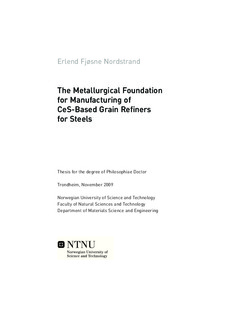| dc.contributor.author | Nordstrand, Erlend Fjøsne | nb_NO |
| dc.date.accessioned | 2014-12-19T13:25:20Z | |
| dc.date.available | 2014-12-19T13:25:20Z | |
| dc.date.created | 2010-01-18 | nb_NO |
| dc.date.issued | 2009 | nb_NO |
| dc.identifier | 287398 | nb_NO |
| dc.identifier.isbn | 978-82-471-1858-0 (printed ver.) | nb_NO |
| dc.identifier.isbn | 978-82-471-1859-7 (electronic ver.) | nb_NO |
| dc.identifier.uri | http://hdl.handle.net/11250/248792 | |
| dc.description.abstract | This doctoral thesis is concerned with experimental studies of the conditions for CeS formations during manufacturing of Ce-S/Ce-S-Al/Ce-S-Al-Fe based grain refiners for steels. The thesis is divided into five parts. Part I gives a general introduction to the concept of steel grain refinement by means of heterogeneous nucleation of acicular ferrite at non-metallic inclusions during the austenite to ferrite transformation.
In Part II the conditions for cerium oxide and oxysulphide formation during manufacturing of CeS-based grain refiners for steel have been examined. The small vacuum furnace used in these laboratory experiments is equipped with a graphite heating element, where both the temperature-time programme and the partial pressure of oxygen can be accurately controlled and monitored throughout the melting trials. The results from the optical and electron microprobe examinations of the as-solidified samples show that the liquid Ce-S-Fe-Al melt is prone to oxidation up to about 1600 to 1800 ˚C before the graphite heating element starts to act as an effective oxygen scavenger. The oxidation leads to conversion of CeS to Ce2O2S, which is an undesirable microconstituent in the grain refiners. In practice, the problem can be overcome by the use of rapid heating of the melt, which in the present small-scale laboratory experiments needs to be as high as 1000 ˚C/min in order to kinetically suppress the oxygen absorption from the shielding gas.
In Part III the phase relations within the Ce-Al-Fe-S system have been clarified, using a combination of optical microscopy and WDS microprobe analyses. As a starting point highpurity charge materials of cerium, aluminium and FeS2 are melted and superheated to about 2000 ˚C within small tantalum crucibles inside a dedicated laboratory furnace filled with cleaned argon. The phases detected in the as-solidified samples were CeS, Ce3Al, Fe2Ce and γ-Ce, along with Ce2O2S, which is an undesirable microconstituent in CeS-based grain refiners. It is concluded that FeS2 can be used as a sulphur source for addition up to about 4 wt% sulphur. At higher levels the Fe-Ta interaction becomes so vigorous that tantalum no longer acts as an inert refractory metal and wetting becomes a major problem. In contrast, aluminium is an essential alloying element in the sense that it prevents the grain refiners from disintegrating in contact with air due to internal oxidation of free cerium by promoting the formation of Ce3Al.
In Part IV the phase relations within the Ce-S-Al system have been clarified, using a combination of optical microscopy and WDS microprobe analyses. As a starting point high purity charge materials of cerium, aluminium and Ce2S3 were melted and superheated to about 2000 ˚C within small tantalum crucibles inside a dedicated laboratory furnace filled with cleaned argon. The main constituent phases detected in the as-solidified samples are CeS, Ce3Al, CeAl and γ-Ce, where the CeS phase constitutes a discontinuous dendritic network within the grain refiners. The melting experiments show that pure cerium can dissolve about 6 wt% of sulphur at 2000 oC which drops to approximately 1.8 wt% at 1500 oC. The measured sulphur solubility is considerable lower than that inferred from the existing binary Ce-S phase diagram, which therefore should be revised to comply with these new measurements. Because alloying with aluminium reduces the sulphur solubility in liquid cerium, the addition of this element should be restricted if a high volume fraction of CeS is desired in the grain refiners. At the same time the use of Ce2S3 as a sulphur source in replacement of pyrite (FeS2) means that aluminium is not actually needed to prevent the grain refiners from disintegrating in contact with air due to internal oxidation.
Finally, in Part V up-scaled production of the CeS-based grain refiners has been attempted. As a starting point, batches of about 0.5 kg are made from high purity charge materials of γ-Ce and Ce2S3 within a suitable molybdenum crucible using an inductive heating chamber furnace filled with pure argon. Following casting in a water-cooled copper mould, the main phases observed in the as-solidified samples are γ-Ce and CeS. Also some Ce2O2S could be detected, but the amount is small, meaning that oxygen pick-up is not a major problem in these up-scaled melting experiments. Furthermore, attempts have been made to re-melt and rapidly solidify one of the produced grain refiners using melt spinning. The experiments show that a fine distribution of spherical-shaped CeS particles with a mean diameter close to 1 µm can be produced by means of this technique. This size is deemed to be optimal with respect to nucleation of acicular ferrite in steels during the austenite to ferrite transformation. Finally, a new and improved production method for CeS-based grain refiners has been suggested, which allows large quantities of materials to be melted, superheated and rapidly quenched in a single batch operation. The idea here is to use gas atomization as the main quenching technique for liquid cerium instead of melt spinning in combination with induction heating and bottom tapping of the crucible. | nb_NO |
| dc.language | eng | nb_NO |
| dc.publisher | Norges teknisk-naturvitenskapelige universitet, Fakultet for naturvitenskap og teknologi, Institutt for materialteknologi | nb_NO |
| dc.relation.ispartofseries | Doktoravhandlinger ved NTNU, 1503-8181; 2009:227 | nb_NO |
| dc.title | The Metallurgical Foundation for Manufacturing of CeS-Based Grain Refiners for Steels | nb_NO |
| dc.type | Doctoral thesis | nb_NO |
| dc.contributor.department | Norges teknisk-naturvitenskapelige universitet, Fakultet for naturvitenskap og teknologi, Institutt for materialteknologi | nb_NO |
| dc.description.degree | PhD i materialteknologi | nb_NO |
| dc.description.degree | PhD in Materials Technology | en_GB |
